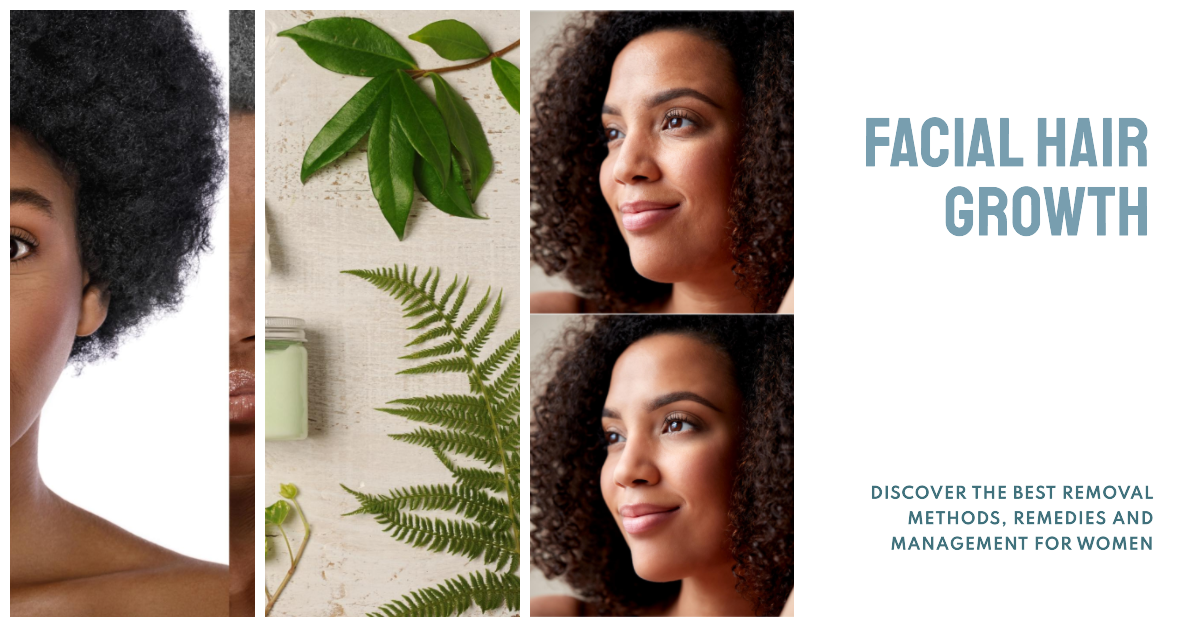In This Article
- 1 Understanding Facial Hair Growth
- 2 Methods of Facial Hair Removal
- 3 Home Remedies for Facial Hair
- 3.1 Natural Solutions for Fine Facial Hair
- 3.2 1. Turmeric and Milk Mask: A Brightening Blend
- 3.3 2. Sugar and Lemon Scrub: Exfoliation and Hair Reduction
- 3.4 3. Egg White Mask: Temporary Hair Removal
- 3.5 Cautionary Advice on Home Remedies
- 3.6 1. Patch Testing: Avoid Allergic Reactions
- 3.7 2. Consistency is Key: Results May Vary
- 4 Managing Facial Hair Growth
Understanding Facial Hair Growth
Facial hair growth is a topic of great fascination and concern for many individuals. It’s a natural aspect of human development that is influenced by a complex interplay of genetics, hormones, and other factors. Understanding how and why facial hair grows, as well as the methods available for managing it, is essential for both men and women. Whether you’re looking to embrace your facial hair or seeking effective ways to reduce its appearance, this exploration of facial hair growth will provide valuable insights and guidance to help you navigate this aspect of personal grooming and self-expression [1].
Factors Influencing Facial Hair Growth
Facial hair growth is a multifaceted process driven by two primary factors: genetics and hormones. These influential elements collaborate to define the thickness and density of facial hair, creating distinct patterns for each individual.
1. Genetics: The Blueprint of Facial Hair
Genetics serve as the foundational blueprint for facial hair growth. The genetic code inherited from one’s parents profoundly shapes the potential for facial hair development. If familial history showcases a lineage of robust facial hair, a similar outcome is more likely. Conversely, a sparse family history in this regard might result in limited facial hair growth.
2. Hormones: The Catalyst for Growth
Hormones, notably testosterone, act as the catalyst for facial hair growth. During puberty, an upsurge in testosterone initiates the development of thicker and darker facial hair. However, the response of hair follicles to these hormones can vary significantly among individuals, influencing both the rate and extent of growth.
Variation in Hair Thickness and Density Across Facial Regions
Understanding facial hair growth goes beyond genetics and hormones; it also entails acknowledging the differences in hair thickness and density across various facial regions.
Chin and Jawline: The Denseness Zone
The chin and jawline are typically denser areas for facial hair growth. Here, hair tends to be coarser and more abundant, creating the foundation for a robust beard.
Cheeks and Upper Lip: The Fine and Sparse Regions
In contrast, the cheeks and upper lip often feature finer and sparser hair growth. These areas may develop at a slower pace and with less density due to variations in follicular sensitivity to hormones.
Key Takeaway: A comprehensive understanding of facial hair growth necessitates recognizing the intertwined influence of genetics and hormones while appreciating the regional diversity in hair thickness and density across different parts of the face. This dynamic interplay results in the distinctive facial hair patterns that characterize each individual.
Methods of Facial Hair Removal
Facial hair removal is a grooming practice that many individuals engage in to achieve a smooth, hair-free face. Several methods are commonly used, each with its own set of advantages and drawbacks, making it essential to choose the right one based on individual preferences and needs.
1. Shaving: Quick and Convenient
Shaving is perhaps the most accessible and widely used method for facial hair removal. It offers a quick and convenient solution, suitable for most people. However, it has its downsides. Shaving can lead to stubble regrowth, and for some, it may cause irritation or ingrown hairs.
2. Waxing: Longer-Lasting Smoothness
Waxing provides longer-lasting results by removing hair from the root. It’s suitable for those seeking a smooth face for an extended period. However, it can be painful and may cause redness or irritation, making it less ideal for individuals with sensitive skin.
Related: Waxing 101: All that You would want to Know about the Rica Waxing
3. Threading: Precise and Less Irritating
Threading is a precise method, often chosen for shaping eyebrows or removing fine facial hair. It is less likely to cause skin irritation compared to waxing or shaving, but it can be uncomfortable during the process. Threading is a viable option for those with sensitive skin.
4. Laser Hair Removal: Semi-Permanent Solution
Laser hair removal offers a semi-permanent solution to facial hair. It’s effective in reducing hair growth over time. However, it typically requires multiple sessions, can be costly, and may not work as effectively for people with light hair or darker skin tones.
Key Takeaway: Various methods of facial hair removal cater to different preferences and needs. Shaving is convenient but may lead to stubble. Waxing offers longer-lasting smoothness but can be painful. Threading is precise and less irritating but uncomfortable. Laser hair removal provides a semi-permanent solution but may not be suitable for all. Choosing the right method depends on individual considerations and desired outcomes.
Home Remedies for Facial Hair
Natural Solutions for Fine Facial Hair
When it comes to dealing with fine facial hair, many individuals prefer natural or DIY remedies as an alternative to chemical treatments. These remedies not only aim to reduce the appearance of facial hair but also promote healthier skin. Here are some effective options:
1. Turmeric and Milk Mask: A Brightening Blend
The turmeric and milk mask are a time-tested remedy. Turmeric, known for its natural bleaching properties, can gradually reduce the visibility of fine facial hair. It additionally bestows a luminous radiance upon the skin. To make this mask, mix a teaspoon of turmeric with enough milk to form a paste. Apply it to the face, leave it on for about 15-20 minutes, and then rinse it off gently.
2. Sugar and Lemon Scrub: Exfoliation and Hair Reduction
A sugar and lemon scrub serves a dual purpose: exfoliating the skin and reducing the appearance of facial hair over time. Sugar acts as a gentle exfoliant, while lemon’s natural acidity can lighten hair. However, it is important to note that lemon juice can cause skin sensitivity or irritation in some individuals. To create the scrub, mix sugar and freshly squeezed lemon juice to form a paste, gently massage it onto the face, and then rinse it off with warm water.
3. Egg White Mask: Temporary Hair Removal
Egg white masks are known for their temporary hair removal effects. When applied and allowed to dry, they create a thin, peelable film that may help in pulling out fine hairs. To make an egg white mask, whisk an egg white until frothy, apply it to the face, allow it to dry, and then peel it off gently.
Cautionary Advice on Home Remedies
While these home remedies can be effective, it is crucial to exercise caution:
1. Patch Testing: Avoid Allergic Reactions
Before applying any remedy to your face, perform a patch test on a small, inconspicuous area of your skin. This precaution helps identify any potential allergies or adverse reactions to the ingredients. Some individuals may experience skin sensitivity or irritation, particularly with lemon-based remedies.
2. Consistency is Key: Results May Vary
It’s important to understand that home remedies often require consistent use and patience. Results may vary from person to person, and it may take some time before you notice a significant reduction in facial hair. Avoid the temptation to use these remedies aggressively or too frequently, as this can lead to skin irritation or other adverse effects.
Key Takeaway: Natural remedies offer a DIY approach to addressing fine facial hair while promoting healthy skin. The turmeric and milk mask, sugar and lemon scrub, and egg white mask are popular options. However, always exercise caution by conducting patch tests to check for allergies and be patient and consistent in your approach, as results may take time to become noticeable.
Managing Facial Hair Growth
Long-Term Strategies: Hormonal Treatments and Prescription Medications
When it comes to managing facial hair growth over the long term, individuals may explore various options, including hormonal treatments and prescription medications. These strategies are particularly relevant for those seeking more permanent solutions or dealing with conditions like hirsutism.
1. Hormonal Treatments: Regulating the Culprit
Hormonal imbalances can often lead to excessive facial hair growth. Hormone therapy, such as oral contraceptives or anti-androgens, can help regulate these imbalances. Oral contraceptives can be effective in managing hair growth in women by reducing the levels of androgens, the male hormones responsible for hair growth. Anti-androgens, on the other hand, directly block the action of androgens in the body. These treatments require consultation with a healthcare provider, as they come with potential side effects and should be tailored to individual needs.
2. Prescription Medications: Targeted Approaches
Prescription medications like eflornithine (Vaniqa) offer a targeted approach to managing facial hair. Eflornithine inhibits the enzyme responsible for hair growth, leading to slower regrowth and finer hair. It is applied topically and can be used in combination with other hair removal methods [2].
3. Consulting a Dermatologist: Personalized Guidance
The importance of consulting a dermatologist cannot be overstated when considering long-term strategies for managing facial hair growth. Dermatologists can provide personalized guidance, assess underlying causes, and recommend the most suitable treatment options. They can also monitor progress and adjust treatments as needed to ensure safe and effective management of facial hair growth.
Key Takeaway: Managing facial hair growth through long-term strategies involves hormonal treatments and prescription medications. These options should be pursued under the guidance of a dermatologist to ensure personalized care and effective results. Hormone therapy and prescription medications can offer lasting solutions for those dealing with unwanted facial hair, but it is essential to weigh the benefits and potential side effects in consultation with a healthcare professional.












I will immediately grab your rss feed as I can’t to find your e-mail subscription link or e-newsletter service. Do you have any? Please let me understand so that I may just subscribe. Thanks.